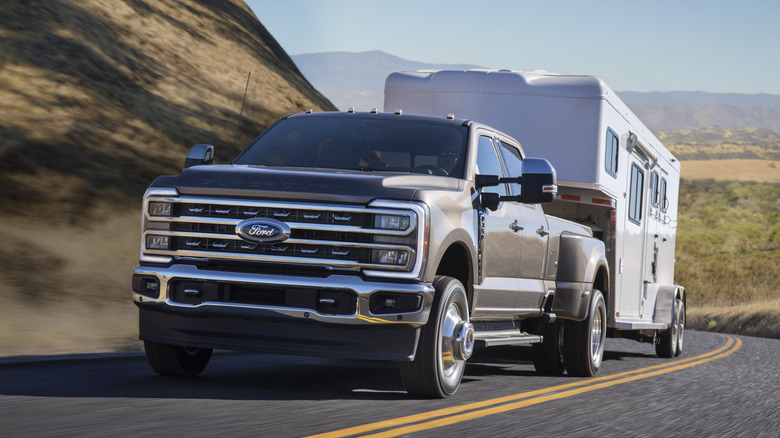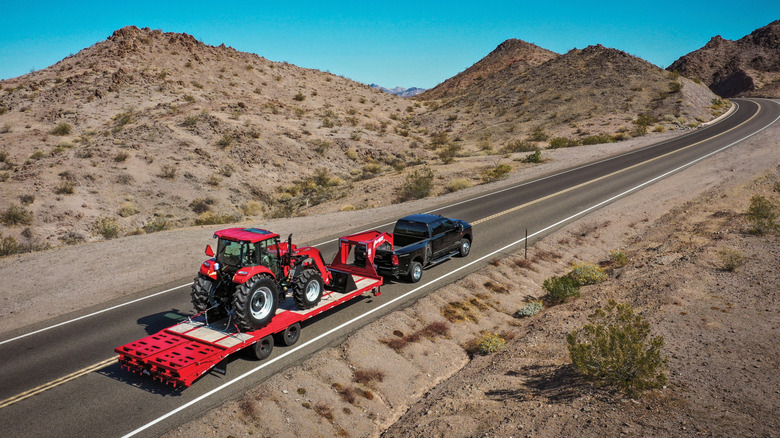How Do Car Manufacturers Determine Towing Capacity? (And Why You Should Never Go Over It)
There are lots of different numbers associated with your car's capabilities. Knowing a vehicle's ground clearance or approach angle can help with understanding a vehicle's off-road abilities, for instance. The payload, gross vehicle weight rating (GVWR), and maximum towing capacity numbers, however, are very important to know if you plan on pulling a trailer. After all, what's the point in buying that shiny new SUV if it doesn't have the power to pull your boat to the lake on the weekends? If the payload number on your new pickup is so low that you can't throw a few motorcycles in the back, you might be pretty upset with your purchase.
If you plan on doing any towing, checking the door sticker or the manufacturer's site for payload and towing ratings should be one of your first steps in the car-buying process. Those numbers will let you know just what the limits of your vehicle are — and when it comes to towing, different classes of vehicle have very different limits. Typically, small trucks like the Ford Maverick or the Hyundai Santa Cruz are lower — below 5,000 pounds. Full size pickup trucks rise from there, and eventually you get to serious heavy-duty bruisers that can tow massive trailers via fifth-wheel or gooseneck connections. For the most part, those numbers are calculated using a certification process known as SAEJ2807.
SAE's process for setting tow numbers
SAE stands for the Society of Automotive Engineers. J2807 is the current towing standard used by the organization and the tow ratings it assigns to different vehicles are based on a specific set of criteria. The standards were originally issued in 2008 and they've been revised a few times since then, but they still test many of the same parameters. The SAE tests a vehicle's ability to perform certain tasks like launching from a start, launching on an uphill grade, and starting up a grade while in reverse.
Towing a maximum load up a steep grade is part of the test too. In particular, the Davis Dam Grade test includes a big towing pull up 11 miles of Arizona highway, while the outside temperature is a minimum of 100 degrees Fahrenheit. One particular test requires that tow vehicles accelerate from 0-30 mph in 12 seconds or less while towing a trailer. Other SAE tests that are part of the J2807 standard require that tow vehicles go from 0-60 mph in a certain amount of time, and from 40-60 mph in a set time. Other tests include braking and emergency lane-changes while towing, done while towing the maximum load specified by the automaker.
Why you shouldn't go over
You might be able to pull a trailer that outclasses your vehicle's rating for a short distance, but you're playing with fire. Physical components of a vehicle's towing connections could fail when pushed beyond their limits, and potentially disable the vehicle. Overheating the engine or transmission is also a big concern when towing a heavy load — you could be left stranded or with big repair bills if either of those fail. A less-likely, but still possible scenario, is that the trailer could come disconnected entirely — an extremely hazardous situation for you and for other motorists. Basically, it's very unsafe and you shouldn't do it.
Brakes, tires, and suspension will all be under increased stress too. All of those systems are designed with certain load limits in mind and going beyond those limits could cause major problems, like severely impacted braking distances or loss of control of the vehicle. And aside from the catastrophic damage that could occur from going over your tow limit, there are other, smaller drawbacks that may take some time to show up. Premature wear and tear on suspension components, the drivetrain, and the towing connections (things like the trailer hitch) are all possible if you tow above the limit on a regular basis. Plus, it's just plain frustrating trying to pull a trailer that is well beyond your vehicle's limit.


